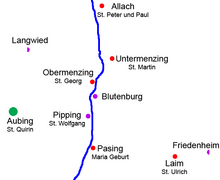St. Wolfgang (Pipping)
The Catholic branch church St. Wolfgang in Pipping is the last completely preserved Gothic village church in Munich . The listed (no. D-1-62-000-5356) church is an exquisite example of the medieval, village-like sacred architecture of Upper Bavaria.
location
St. Wolfgang ( Pippinger Straße 49a) is located in the center of the old village center of Pippings , surrounded by the Pipping cemetery .
history

Excavations from 1977 show a previous building that was built in the 14th century. Duke Sigismund decided to rebuild the church, which on the pilgrimage in the footsteps of St. Wolfgang from Regensburg to the Salzkammergut . Jörg von Halspach is believed to be the master builder . According to a memorial plaque from 1848 on the church, the foundation stone was laid on May 5, 1478, and the church was consecrated on August 13, 1480, the Sunday before Ascension Day . This information has not yet been confirmed in a document. The construction period for the church and furnishings is assumed to be 1480 to 1485.
No changes have been made to the church since then. In 1701 the village church was included in the overall planning of the Nymphenburg Palace Park as the point de vue . Fortunately, this decision did not result in a renovation in the Baroque style . After a lightning bolt struck the tower in 1794, the pointed helmet was added.
In 1924 the new parish church of Leiden Christi in Munich- Obermenzing was inaugurated; At that time St. Wolfgang became a branch of the Passion of Christ. St. Wolfgang survived the Second World War without damage. Between 1976 and 1982 the interior of the courtly-looking church was renovated. In 2005 the frieze painting in the apse was renovated and the window frames repainted.
In July 2008, during an inspection of the roof structure, severe damage was discovered, which led to the church being closed due to the risk of collapse. The impending collapse could be averted at short notice by supporting the ceiling vault. The structural damage was probably a long-term consequence of the lightning strike of 1794.
By October 2011, almost 200,000 euros in donations had been collected to restore the church. The ceremonial reopening took place on October 30, 2011. The church is now used regularly again. It again conveys a uniform impression that corresponds to the time it was created.
Significant works
- Three-part high altar shrine with St. Wolfgang and landscapes of the Salzkammergut, late Gothic, probably by a pupil of Jan Polack , from 1480
- Marien Altar and Leonhard Altar, late Gothic, probably by a pupil of Jan Polack. Vera Ikon on the predella of the right side altar .
- Pulpit , late Gothic, made of stone
- Wall paintings by Jan Polack, 1479
- Facade painting with heraldic motifs of the House of Wittelsbach , late Gothic
- Statues of a crucifixion group by Erasmus Grasser , 1485/90, meanwhile in the Bavarian National Museum
- Bells, cast by Ulrich von Rosen from 1485
literature
- Klaus Gallas : Munich. From the Guelph foundation of Henry the Lion to the present: art, culture, history . DuMont, Cologne 1979, ISBN 3-7701-1094-3 (DuMont documents: DuMont art travel guide).
- Georg Dehio (welcomed), Ernst Götz u. a. (Ed.): Handbook of German Art Monuments, Bavaria IV: Munich and Upper Bavaria. 3rd, updated edition, Deutscher Kunstverlag Munich / Berlin 2006, pp. 800–802. ISBN 978-3-422-03115-9 .
- Adolf Thurner (Ed.): The St. Wolfgang Church in Pipping . Self-published, Munich 1990, ISBN 3-9802402-0-7 .
- Lothar Altmann: http://www.zeitschrift-amperland.de/download_pdf.php?id=1021 In: Amperland , 1990, pp. 568-571.
- Parish of Leiden Christi (ed.): St. Wolfgang Pipping - A handout for church visitors . Self-published, Munich 2013.
Individual evidence
- ↑ according to Dehio manual "with little authorization"
- ↑ Parish of Leiden Christi (ed.): St. Wolfgang Pipping - A handout for church visitors. Self-published, Munich 2013
- ↑ http://www.bvobermenzing.de/html/st__wolfgang_pipping.html
- ^ A b Judith Ammon, Almuth David: Kulturlandschaft Würm: from Pasing to Allach . Construction Department of the City of Munich
Web links
Coordinates: 48 ° 9 '23.5 " N , 11 ° 27' 26.7" E




